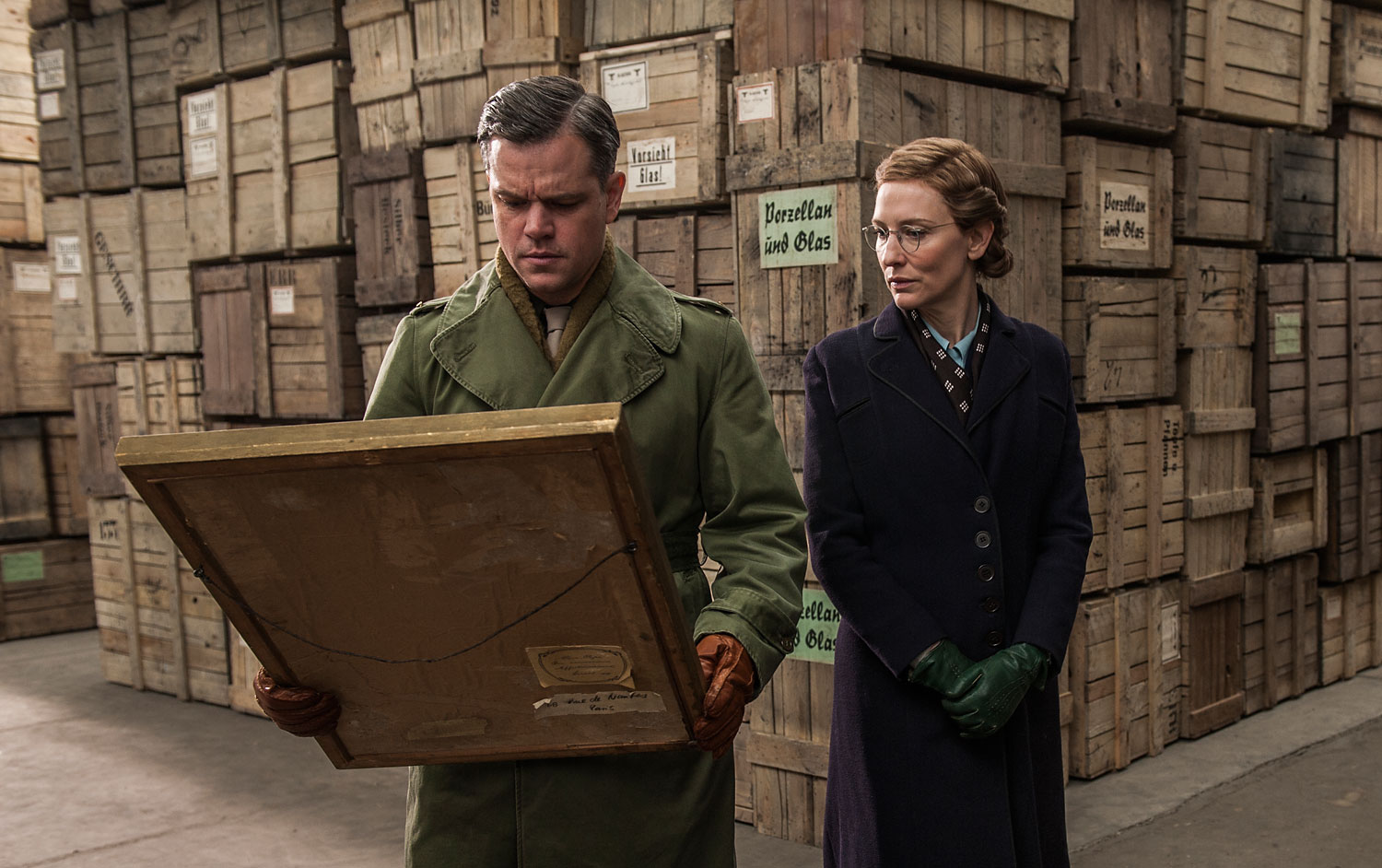
In The Monuments Men, George Clooney’s well-intentioned new film about a team of Allied soldiers attempting to protect and recover art plundered by the Nazis, the character played by Matt Damon — an art historian charged with cataloging the contents of a warehouse filled with items looted by the Nazis — notices a Paris address printed on the back of one small canvas. Inspired to take some small positive step in the face of such an overwhelming task, he follows the address to an abandoned apartment (helpfully daubed with anti-Semitic graffiti). A faded rectangle of wallpaper and a forlorn nail await the painting, and he hangs it where it so clearly belongs. We understand that he is satisfied that he has, even if in a small way, done his job.
(MORE: George Clooney’s Art of War)
Leaving aside the question of whether a Paris apartment would have remained empty for two full years after the infamous July 1942 roundup of Parisian Jews in the Vel d’Hiver — when its fictional owners would likely have been arrested and eventually deported to Auschwitz — the hollowness that accompanies the return of this painting to the empty apartment highlights the conundrum that will always haunt any attempt to come to terms with this subject matter: To whom does property belong when the people who once owned it have been exterminated?
No tale, perhaps, illustrates that tortured question better than the bizarre saga of the so-called Hungarian Gold Train.
(MORE: ‘The Monuments Men’ Was Based on a True Story: See the Photos)
In their zeal to eradicate every trace of the Jewish population of Europe, the Nazis and their eager confederates seized property of all kinds; in Hungary, for example, the fascist Arrow Cross government compelled the Jewish population to turn over everything from stamp collections to fur coats, china services to jewelry, before deporting them to be murdered in Auschwitz. Though much of this state-sanctioned plundering was subject in turn to private pilfering by government looters as the war came to an end and the invading Russian Army closed in on Budapest, a vast quantity of Jewish property was loaded onto a single 42-car freight train and sent in the general direction of Berlin.
After perambulating for months through the devastation of Central Europe, the Hungarian Gold Train (as it had by then come to be known) ended up in the hands of the victorious U.S. Army headquartered in Salzburg — and with it the dilemma of what to do with its contents. Most of Hungary’s Jews were dead, and though the surviving remnant clamored to have the contents of the Gold Train returned to them, U.S. officials had good reason to believe that no property turned over to the new, Soviet-controlled Hungarian government would ever end up in the hands of its original owners. Refugee agencies pressed the U.S. to turn the contents over to them to be sold, with the proceeds then being used to care for the 850,000 Jewish survivors of the war languishing in Displaced Persons camps throughout occupied Germany and Austria.
The train was unloaded, its contents were cataloged and stored in a giant warehouse, and there, while agencies and governments debated, it sat. Meanwhile, high-ranking American military officers of the Occupation, facing inevitable supply shortages, began requisitioning items from the train to furnish their quarters and offices. The warehouse became a kind of Sears catalog from which generals like Harry J. Collins, the military governor of U.S.-occupied Austria, and others ordered furniture, carpets, bedding, dishes, crystal and more.
Ultimately, what remained of the looted property of the Jews of Hungary after it had been pilfered, picked at and requisitioned was sold at auction in New York City in 1948. Estimates of the value of the contents of the Gold Train when it set out on its journey had ranged from $50 million to $350 million. The auction at Parke-Bernet netted $152,850.61.
Though shocking, this paltry figure seems inevitable. I own a pair of silver candlesticks my great-grandmother brought with her out of Russia when she emigrated at the turn of the last century. To me, those candlesticks are priceless, their value beyond measure. But what is the worth of a pair of silver candlesticks when there could be no great-granddaughter to inherit them? And what is the worth of tens, even hundreds of thousands of such candlesticks, when their owners have vanished into ash?
The story of the Hungarian Gold Train ends in that most American of ways: in litigation. A lawsuit brought against the U.S. government for its role in the looting of the contents of the Gold Train was settled, in 2005, for $25.5 million, the funds to be distributed to Jewish social-service agencies for the benefit of Holocaust survivors. But neither that settlement nor films like The Monuments Men offer an answer to the question of what it can possibly mean to “return the possessions” of the victims of genocide. The people to whom it had meaning are gone. All that is left is an empty space on the wall, framed in dust.
Ayelet Waldman is the author of Love and Treasure, to be published by Knopf on April 1.
More Must-Reads from TIME
- Donald Trump Is TIME's 2024 Person of the Year
- Why We Chose Trump as Person of the Year
- Is Intermittent Fasting Good or Bad for You?
- The 100 Must-Read Books of 2024
- The 20 Best Christmas TV Episodes
- Column: If Optimism Feels Ridiculous Now, Try Hope
- The Future of Climate Action Is Trade Policy
- Merle Bombardieri Is Helping People Make the Baby Decision
Contact us at letters@time.com